112015_YKPT_B4.pdf



4B Heritage 2015
The Flood
That Changed
Vermillion
Forever
November 20, 2015 www.plaintalk.net
Passing The Test Of Time: Still
Standing In Historic Downtown
BY SHAUNA MARLETTE
shauna.marlette@plaintalk.net
Editor’s Note: information compiled from “Life in Vermillion Before the Flood of 1881 and Shortly
After” (A.H. Lathrop); “The Vermillion Story” (Everett W. Sterling);
“History of Vermillion and Clay
County South Dakota” (Elizabeth T.
Smith); Dakota Republican Newspaper; and the Vermillion Plain Talk
Newspaper.
The winter of 1880-81 would be
one for the record books in Vermillion and Clay County.
In the rural areas, harsh
weather began to take its toll during the third week of October. A
five-day snowstorm brought heavy
losses of cattle and hogs as well as
considerable property damage.
The Missouri River was frozen
solid by the middle of November.
Teams were crossing the river at
an unusually early date. By Christmas, coal was in short supply.
Heavy snowfall in February
put fuel in short supply. By early
March, many farmers were using
corn for fuel. The Vermillion flour
mill was using willow wood.
The local newspaper reported
on February 10 that the 30 inches
of snow on the ground was the
heaviest accumulation in the history of the territory.
By the time March 1881 rolled
around in Vermillion it had already
been a long, historic winter. The
snow was as deep as ten feet in
many areas, ice on the Missouri
River was three-feet thick. Trains
were not running do to the snow.
As the residents wished for
spring, little did they know that
the warming temperatures would
create havoc in the community
and change the city of Vermillion,
forever.
The spring thaw that year came
first to Montana. The waters from
the thaw reached Yankton and Vermillion before the ice locally had a
chance to melt and breakaway. In
mid-March, a 10-foot rise over the
frozen Missouri at Yankton became
a cause for concern. According
to newspaper reports the general
feeling was that the expanse of the
bottom land between Yankton and
Vermillion would provide enough
area for the waters to spread.
Instead, the water from upstream led to ice gorges in several
places, including one at the mouth
of the James River. When this
gorge gave way, water and ice began to pour over the river bottom.
An ice jam formed on the night
of March 27 at Vermillion. The waters from upstream began to run
into the streets at about midnight.
The Baptist Church bell sounded
the alarm as townspeople fled to
the hillside and the bluff.
Before all the residents reached
safety, the water had risen to three
feet on the north edge of Vermillion. Boats were used to rescue
those who heard the alarm too
late.
Over the next few days, water
continued to rise. Residents
returned to their homes only in
an attempt to salvage some of
their goods. Little could be done
to prevent looting of abandoned
property.
By Thursday, March 31, and
Friday, April 1, ice on the river
began to move. A blizzard at the
same time made salvage efforts
almost impossible. During the
day, 40 buildings were swept from
their foundations, before being
splintered to pieces and strewn
over the ice gorge.
The river wasn’t finished yet.
On April 6, waters heavy with ice
chunks swept through the town.
Within a few hours, 56 additional
buildings were carried from their
foundations. Among the buildings
destroyed were the St. Nicholas
Hotel, the railway depot, the Congregational Church and Shafer’s
Store building. When the water
was at its highest, it was reported
more than 20 buildings were floating at the same time.
While nearly three-fourths of
Vermillion was destroyed: a total
of 132 buildings were totally destroyed and the value of property
lost was set at $142,260. Thankfully only six people in Clay County
lost their lives to the flood.
In addition to the structures
of the community, the Dakota
Southern Railroad lost many miles
of line. Bridges at Sioux City and
Yankton were destroyed, but the
bridge at Vermillion was high
enough to escape damage. A
freight car served as a depot until
the structure was rebuilt. Rail service from Sioux City was not fully
restored until May 27.
After the flood, the citizens of
Vermillion made the decision to rebuild the town on top of the bluff.
COURTESY PHOTO: BILL WILLROTH SR.
Downtown Vermillion in 2011.
BY SARAH WETZEL
For the Plain Talk
Downtown Vermillion has gone through
several generations of historic buildings,
especially since the flood of 1881 when the
decision was made to relocate the town
above the bluffs.
Though some sites have been permanently laid to rest for various reasons, 16
historic buildings are still standing and
continue to be used.
The Austin-Whittemore House located
at 15 Austin St. was built 1882 by Horace
Austin. It was donated in 1960’s by Helen
Whittemore to Clay County Historical
Society and renovated. Now it serves as a
museum and home base of the Clay County
HIstorical Society
The Old National Guard Armory at 111
Market St. was built in 1941. There was
previously no adequate facilities to house
the two National Guard Units stationed in
Vermillion. The building is still being used
for National Guard purposes.
The South side of 10 Block of West Main
was rebuilt in brick after a fire in 1890 destroyed most of the block. The city passed
an ordinance banning new wood frame
buildings in the business district, hence the
iconic brick look. The block still houses various businesses today.
The Bank of Vermillion or First National
Bank at 1 East Main St. went through several
facelifts before it became what we know
as Red’s Steakhouse today. It was the first
bank built on the bluff built first in 1892
with wood. When fire destroyed it, the
building was rebuilt in 1893 with stones and
sandstone trim which was replaced in 1929
with a flat concrete front and given a single
entrance. In 2009 all sandstone trim was
removed and replaced with concrete.
The Old Lumber Company Grill and Bar
used to be a regular lumber yard which
moved from below the bluffs to the Grill’s
current location in 1883. The brick building
was built in 1919 on part of the yard and
was used for not only lumber but implements, automobiles, woodworking and
hardware. It was last was used as a lumber
yard in 1970’s.
Many businesses made use of the building. It served as a general goods store,
department store, discount store, print service and health club. It was restored to near
original condition in 2012 and reopened as
the current Old Lumber Company Grill and
Bar and is used for many local events.
The U.S. Post Office building was a longawaited project. Postal service in Vermillion
was very transient once Vermillion was
moved up the bluffs. It wouldn’t be until
1931 that the current post office building
was completed so they had a permanent
home. The postal service remains there to
this day.
The Carnegie Library was built 1903
and was the first time library had its own
building, previously being located in a room
in city hall. A $10,000 grant from Andrew
Carnegie made it possible for the library
to be built. It is currently a law office and
neighbor to the present-day Vermillion
Public Library.
The Baptist Church on 101 E. Main St. is
one of three historic churches in downtown
still standing. It was dedicated 1890 with an
addition built in 1925 and provides a majestic stone jewel in the downtown skyline.
The United Church of Christ on 225 E.
Main St. is another church which has stood
the test of time, dedicated in 1929. It is still
used for its original purpose today.
The First United Methodist Church’s
currently standing building on 16 North
Dakota St. was built in 1920. It was built to
COURTESY PHOTO: CLAY COUNTY HISTORICAL SOCIETY
In this undated photo downtown Vermillion can be seen prior to paving the
roads.
COURTESY PHOTO: ARTHUR RUSCH
This undated photo shows the Vermillion downtown area prior to the flood
of 1881.
house the growing Methodist congregation
after several moves including the previous
building being destroyed by fire in 1927. The
Vermillion Welcome Table takes place here
as well as the headquarters for the backpack program.
The Charcoal Lounge on 8 East Main St.
was built in 1894 after the block fire the year
before. It has housed billiard parlors/pool
halls, bowling alleys, a women’s store and
a second hand store. It is currently a bar/
night club.
The Grange/Waldorf Livery on 26-28
Center St. is a symbol of Vermillion’s progression. There was a livery at that location since Vermillion moved up the bluff.
The current structure was built in 1902 to
accommodate new business from the new
Waldorf Hotel opening. Has been home to
several businesses, including currently Bike
Plus and Dakota Decoy Company.
The Clay County Bank/Vermillion Nat’l
Bank on 1 West Main St. was originally Clay
County Bank, one of only two buildings to
survive the downtown fire in 1890. The current structure built in 1896. The Clay County
Spanning The River
Bank merged with its competitor to form
the First National Bank of Vermillion. The
building has housed multiple businesses
since then, currently Amy’s Whoopti Doo
Hair Salon.
Nissen Building/Citizen’s Bank & Trust on
25 W. Main St. was built in the early 1900’s
as a millinery business. Later it housed Citizen’s Bank & Trust then Northwestern Bell
Telephone Company upstairs. It is currently
the home of The Spa at Wynie Mae’s.
St. Agnes Catholic Church on 202 Washington St. was completed in 1907 in place
of a smaller chapel to accommodate two
parishes combining. Currently the church
is headquarters of the Washington St. Arts
Center, home of the Vermillion Area Arts
Council. Art classes, displays and theatrical
and music productions are held here.
The Clay County Courthouse located at
213 West Main St. was built between 1912
and 1913, replacing the original wooden
courthouse built on the bluff in 1881-82. It
still serves as the courthouse and appears
today much as it did when it was built.
Spirit
From Page 3B
PLAIN TALK FILE PHOTO
The the first bridge to cross the Missouri River
between Newcastle, Nebraska, and Vermillion.
Prior to the bridge being built, residents had to
take a 35 mile path to get across the river. In the
14 years that it has been open, it has been a major
boost to the local economies. Ground was broken
for the bridge in July, 2000, and the bridge was
dedicated on November 10, 2001.
predates any human habitation.
The core of the hill is formed
from a rock known as Chalkstone,
similar to limestone, that was
formed as calcium carbonate shells
settled on the bottom of an ancient
ocean and then fossilized into a
large formation called the Niobrara
Formation.
Most of this formation was
removed by glaciers but the Spirit
Mound remained with glacial deposits covering the hill.
The mound continues to fascinate geologists and biologists
today as they struggle to restore the
prairie to its original glory.
The restoration is just as important to animal species as it is to
plants.
Referred to as a ‘Sparrow Haven’
by David Swanson of the Depart-
ment of Biology at the University
of South Dakota, it is a surprisingly
significant area for the birds, some
of which are at risk of becoming
endangered.
“There have been fewer studies
of the importance of grassland habitats as stopover sites for migrating
sparrows than there have been of
woodland and wetland habitats as
stopover sites, but it is likely that
grasslands are just as critical to
maintaining stable populations as
are woodlands and wetlands for
these migrants,” Swanson writes in
the Spirit Mound Newsletter. “...In
any event, Spirit Mound seems to be
a popular stopover location for Le
Conte’s and many other sparrows,
so I encourage you to take your binoculars out for a stroll up the trail
during the fall migration period.
You are likely to be rewarded with a
beautiful variety of sparrows.”
For more information visit www.
spiritmound.com.





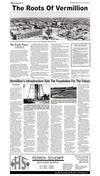
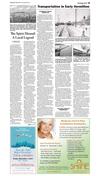
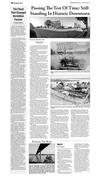
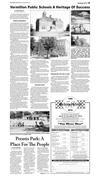


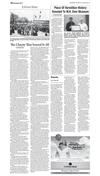
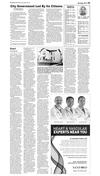



 Previous Page
Previous Page






